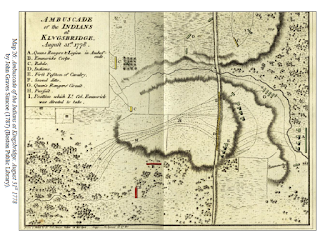One thing I’m usually asked when I’m contacted by a Van
Gilder descendant is how did John Van Gilder get his surname. Unfortunately it hasn’t been documented, but
I have a theory.
Robert S. Grumet wrote in his book The Munsee Indians, A History:
“…Indians in particular tended to identify themselves as
people from a particular place or a certain river. This practice is reflected
in the way they used ‘Delaware,’ a loan word adopted from the English. ‘Delaware’
comes from the name of Thomas West, Baron de la Warr, second governor of the
Virginia colony. Early Virginian
explorers gave his name to the river that Unami-speaking Delawares called Lenapewihittuck and that Munsees called Kithanne, ‘Large River.’ Colonists and
Indians both began calling the river Delaware by the early 1700s. At about the
same time, most Unami- and some Munsee-speaking people living along the river’s
shores began using the word when referring to themselves. Most of their
descendants continue to identify themselves as Delawares….”
Shirley W. Dunn wrote in The
Mohicans and Their Land “Schermerhorn , or Manueenta, also a significant
Mohican sachem and leader, was one of a group of Catskill Mohicans who used
Dutch names.” An abstract in the appendix lists the people she must have been
referring to in a Greene County deed dated 8 July 1678 “Tamongwes alias Volkert,
Papawachketik alias Evert, Mamaetcheek alias Joris, Kachketowas alias Cobus,
and Unekeek called Jan de Backer….Manueenta alias Schermerhorn….” Another member of the band was Catharickseet,
alias Cornelius.
John’s father was Wappinger, who were Munsee, and his mother
was Mohican. Below is an excerpt of the report that New York Attorney General John Tabor Kempe made to New York Governor Mockton dated 2 April 1762.
...Awansous a Wappingoe Indian Grandfather to the
Complainant (Daniel Nimham, the last Wappinger chief) on the mother’s side, was possessed of a certain Tract of Land
lying on the East side of Hudson’s River, beginning at the mouth of the Fish
kills called in the Indian language Nataowawmungh thence running down Hudsons
River southerly to Anthony’s Nose called in the same language Wacoghquanuk, and
Eastward into the woods as far as the Oblong croping the Peeks kill.... Awansous died leaving behind him two Sons
Tawanaut otherwise called John Van Gilder and Sancoolakheekhing, to whom the
Body of the Nation solemnly confirmed their Fathers Land according to the
Custom of their Nation at a publick Toast & sacrifice [sealing their
Grant]. Sancoolakheekhing Died without any Children and on his Death the Nation
confirmed the whole of the Lands to John Van Gilder who was Uncle to the
Complainant, being his Mothers Brother & he [John Van Gilder] in the
year of the Defeat at Ticonderoga (July 1758) hath since given the whole of these Lands to the complainant....
John was also a member of the Catskill band that was on the move since selling their land, and probably was born in northwestern Connecticut. He was living in western Massachusetts by 1707. He identified with the ancestral location so strongly that a non-related, English man was able to provide the name of the band to the New York attorney general in October 1768, and was not contradicted by John’s son Joseph.
John was originally
recorded in a Dutch church record in Kingston as Jan Van Gelder in June 1719. There’s only one record of a Van Gelder living above New York City before the American Revolution, Elizabeth Van Gelder, an elderly woman. She probably was a widow living in the home of an adult daughter. Therefore we know this is the Mohican-Wappinger man otherwise known as "Tawanant" or "Toanunck."
Other men of the Catskill band had starting using Dutch names. A perceptive man, John may have realized that it
was better to have both a first name and a last name, especially since one of the Mohicans was already using Jan. The Munsees identified with a particular place. We know John identified with the Catskill area. Shirley told me that Kaaterskill/Catskill was mostly likely named after a Mohican man named Kaankat who was nicknamed “Cat.” She noted “he signed for the land sold to Rensselaerwyck at Catskill.” “Kill” is definitely Dutch. Either the place names weren’t being used yet in 1719 or John
thought using either version wasn’t appropriate. The Catskill band sold its land to people
from Gelderland which may have been the Duchy of Guelders at the time in the
Netherlands. I believe John took the
surname Van Gelder to memoralize his ancestral land where the people from that foreign
land lived after his band sold its land to them.



